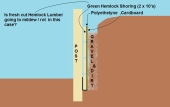posted 1 year ago
Welcome to permies, Graham. I've wondered about this as well, and haven't seen any recommendations for or against. Intuitively, I'd think that charring green softwood would be a great way to go, because the moisture in the interior of the boards will prevent some of the structural weakening that comes with torrefaction. Of course, if you're using it for cladding then it doesn't really need to be all that strong, and you might have more shrinkage to contend with...but that's the whole point of board and batten, to accommodate expansion and contraction and still have a weathertight skin.
I'd be keen to know how it performs if you do go down this path.
On a tangent to this, I'm trying wood vinegar as a preservative on some untreated pine that I'm using to make gates (recycled pallets, not heat treated even). The boards were really dry from being outdoors in the late summer, so when I brushed it on it penetrated well. I don't think you'd have good results putting any type of liquid finish on green timber, but daisugi may be an exception.







